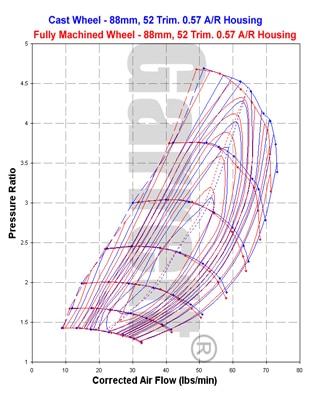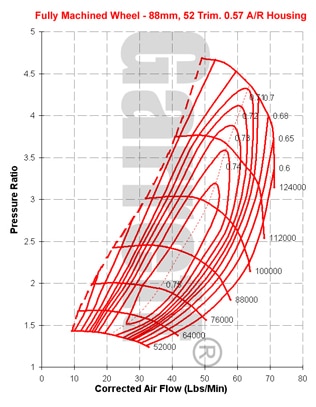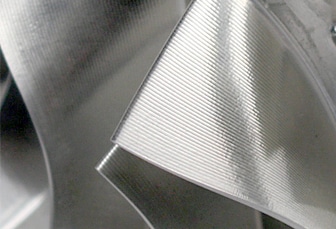Garrett Fully Machined Compressor Wheels
The Garrett GT5533R and GT5541R turbochargers are the only members of the GT family of turbos to feature fully-machined compressor wheels. Fully machined wheels are commonly referred to as “billet.” Why use a fully-machined wheel?
Higher Flowrates, Horsepower or Efficiency?
 No. Garrett® compressor wheels are designed from the ground up to optimize performance. The blade shape and wheel diameter are the most critical factors to optimize to achieve high performance. Garrett® fully-machined (billet) wheels take their blade designs from Garrett® cast wheels. Regardless of the wheel manufacturing process, dedicated aerodynamic engineers spend countless hours using computational fluid dynamics CFD) and finite element analysis (FEA) to design compressor blades.
No. Garrett® compressor wheels are designed from the ground up to optimize performance. The blade shape and wheel diameter are the most critical factors to optimize to achieve high performance. Garrett® fully-machined (billet) wheels take their blade designs from Garrett® cast wheels. Regardless of the wheel manufacturing process, dedicated aerodynamic engineers spend countless hours using computational fluid dynamics CFD) and finite element analysis (FEA) to design compressor blades.
To test this, our engineers ran identically-designed compressor wheels on our gas stands. We removed as many confounding variables as possible; there were no vehicles, no engines, just a test cell and a turbo. The only difference between the wheels tested was the manufacturing process used to create them. One was a fully machined wheel (the red map) and the other was the standard, high-quality cast wheel (the blue map).
Looking at these maps side by side, it is evident that there is little difference between them. The differences seen are well within the testing tolerances set by our laboratories. When the maps are combined, the similarities become even more pronounced.
No noticeable gains in performance can be seen when testing a machined wheel vs. a cast wheel of the same design.

Stronger?
Sometimes, in OE applications, fully-machined wheels can withstand higher centrifugal stresses due to differences in the base material. Forgings are inherently stronger than the typical casting in this respect. However, when Garrett engineers choose a fully-machined wheel over a cast wheel, they are only doing so to prolong the wheel’s life in extreme duty-cycle OE applications where the turbo speed is constantly cycled. A typical example is a city bus, in which the turbo is frequently subjected to rapid transitions between high-load (full throttle) and low-load (idle). Compressor wheels can fail in low-cycle fatigue (LCF) in these applications, which is where fully-machined wheels offer an advantage in strength and lifetime. However, the typical aftermarket turbocharger will not be subjected to such extreme cycling.
Cost and Time to Market?
Yes! The unique configurations of the GT5533R with its 94mm inducer, and the GT5541R with its 106mm inducer required unique wheels that could be created quickly. Creating cast tooling is typically an expensive and drawn-out process. In lower volume turbochargers such as these GT55Rs, choosing a machined wheel reduces the cost per wheel compared to a casting, and allows the turbos to be brought to market rapidly.
For either of these turbos, a cast aluminum wheel using the same dimensions and blade designs would have performed equivalently in most aftermarket applications. In fact, cast compressor wheels are used in the vast majority of the 9 million turbos that are designed, tested and produced each year by Garrett Turbo Technologies’ 500 turbo engineers world-wide.


